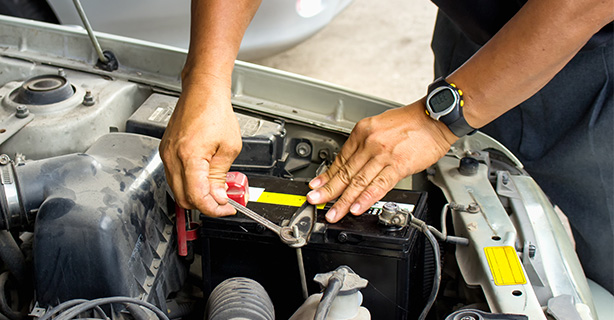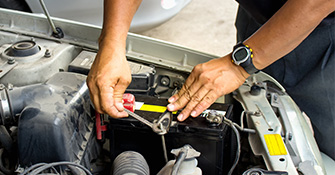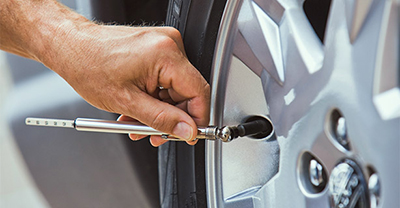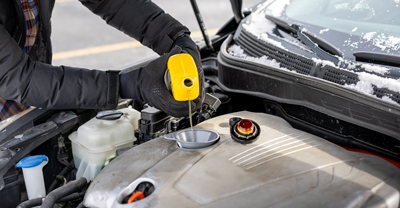How to change a car battery in 8 steps


0 min. read
Think your car battery needs to be replaced? Before spending the extra cash, there may not be a need to go to a repair shop.
Can I replace my car battery myself?
You sure can. With a few tools, you can be back on the road in no time. But before you run down to your nearest auto parts store, it’s important to figure out if you actually need a brand-new battery. Maybe you just need a jump start, but it could be something else.
Some things to check first are the condition of the battery, the terminal connections, and the battery posts (where the terminals connect).
Quick tip: When connecting and disconnecting a car battery, remember the order:
Disconnecting a battery = Disconnect the black/negative terminal cable first.
Connecting a battery = Connect the red/positive terminal cable first.
How to know when your car needs a new battery
Recognizing when your car needs a new battery is crucial to avoid unexpected breakdowns. Here are key signs it might be time to replace your car battery:
Slow engine crank: If you notice the engine cranks slowly when you try to start the car, it could be a sign of a weak battery. A healthy battery should provide enough power for a quick and strong engine turnover.
Dimming headlights and interior lights: When your battery is weak, your headlights and interior lights may appear noticeably dimmer than usual. This can happen when the battery struggles to provide enough power to those components.
Electrical issues: If you experience electrical problems such as power windows moving sluggishly, radio or infotainment system malfunctions, or erratic dashboard warning lights, it could be due to a failing battery.
Visible damage or corrosion: Inspect the battery for visible signs of damage, such as cracks or leaks. Also check for corrosion on the battery terminals and cables. Corrosion can hinder the battery's performance.
Unusual odors: If you detect a sulfuric or rotten egg smell around your battery, it may be leaking gas, which is a sign of a damaged or overcharged battery.
Frequent jump-starting: If you find yourself frequently jump-starting your car—or recharging it with a battery charger—it's a clear indication that the battery isn’t holding a charge effectively.
When you notice one or more of these signs, it's advisable to have your battery tested by a professional or replace it if it's old or displaying significant issues. Most parts stores will test your battery for free and let you know if it needs to be replaced.
Are your battery connections the culprit?
If your car won't start, there are a few DIY repairs you can try before you buy a new battery. If your battery looks normal, check the connections to the terminals. If you drive on bumpy roads a lot, the terminal connections could work themselves loose. If this appears to be the case, tighten the nuts on the connectors with a rubber-handled wrench.
Over time, the battery terminals and terminal connectors may have become corroded. While this can be a sign you need new connectors or a new battery, cleaning the corrosion allows the cables to make a better connection with the posts.
How to clean car battery connections
Starting with the negative connection, loosen and remove both connectors. The negative cable is typically black and connects to the post on the battery with the minus (-) sign. With a wire bristle brush, clean the post connectors and the posts.
If there's a lot of battery acid corrosion buildup, you can also apply a solution of baking soda and water to help loosen and remove it.
Reconnect the terminal cables to the battery beginning with the positive (+) side first this time, making sure the negative terminal connector isn't touching anything when you do this. Then, reconnect the negative connector. Try starting the car again. If it starts, you just saved yourself the price of a new battery.
If you’re faced with the need for a new battery, this eight-step guide walks you through how to replace your car battery with confidence.
Step 1: Prep your vehicle, gather your tools, and take precautions
The risk of injury when working with a car battery is minimal—but that doesn't mean there's no risk at all. It's still important to always take precautions. For instance:
Secure your car. Whenever you work on your car, it’s a good idea to make sure the parking or emergency brake is set to avoid any movement while you’re under the hood.
Wear clothes that cover your arms and legs. Car batteries contain acid which stores the energy that powers your car’s starter and other electrical systems. If this acid comes in contact with your skin, it can cause mild to severe chemical burns.
Carry the battery in its upright position. Hold it away from your body.
Wear gloves. Your leather or rubber gloves don't have to be thick—even a thin layer of rubber acts as insulation against accidental spills and shocks. While these risks are minimal, it's a good idea to err on the side of caution.
Wear safety goggles. Under the hood of your car are all types of debris that builds up, such as road grime, vehicle fluids, and the acid in your battery. While the risk of spilling acid is low, safety glasses keep dirt and fluids out of your eyes when working on your car.
Lift properly. Did you know that some car batteries can weigh as much as 40 pounds? When lifting anything of that weight, or when you're unsure of the weight, it's best to lift by bending your knees and lifting with your legs.
Tools you’ll need to change your battery
Once you're certain you need to replace your car battery, you'll need a few tools to complete the job, such as:
Wire bristle brush
Leather or rubber gloves
Safety goggles
Socket set or adjustable wrench
The new car battery
When you remove the old battery, note where the battery terminals, or posts, are located on the battery. Some batteries have top posts and others have side posts. You'll need a new battery with the same post positions as the old one.
Step 2. Locate the battery and the positive and negative terminals
If you haven’t already, locate your car’s battery. Most of the time it’ll be located under the hood in the engine compartment, but in some cases it could be in a different location like in the trunk or under one of the seats in the interior. If you’re not sure, check your owner’s manual to find out where it is.
Determine which post on the battery is positive and which is negative. The positive terminal has a red cable, and the negative terminal has a black cable. The positive terminal usually has a red plastic cover with a plus (+) sign that pops off the post and remains connected. On the negative side, there usually isn't a cap, and there may or may not be a minus or negative (-) sign.
Step 3: Disconnect the car battery terminals
If your vehicle has a brace that holds the car battery in place, remove this first before disconnecting the terminals.
Begin disconnecting the negative terminal's nut—or bolt, depending on the type of battery—with your wrench in a counter-clockwise direction. You won't need to remove the nut completely, just loosen it enough to remove the terminal connection. Remove the terminal connector from the negative post and, without stretching it, move it out of the way so it won't come into contact with anything.
Repeat these steps for the positive terminal.
Which car battery terminal do you disconnect first?
Remember the quick tip from above:
When disconnecting a battery, start on the negative side.
When connecting a battery, start on the positive side.
Step 4: Remove the car battery
Many car batteries come equipped with a handle for easy carrying. If your battery is older, take care—this handle could be brittle and could break. Use both hands to remove the battery and set it aside. You can bring this to the store where you purchase your new battery and receive your core deposit back.
Step 5: Clean the battery terminals
If you already performed this step when going through the list of potential reasons your car won't start, there's no need to repeat it. If you didn't, go ahead and clean your car battery terminal connectors using a wire bristle brush.
Step 6: Install the new car battery
Once your old car battery is removed and your post connectors are clean, you can install your new car battery. Set it carefully in the battery tray.
Step 7: Attach the terminals to the new battery
Reconnect the positive battery terminal connector first, then the negative, and tighten the nuts on the connectors so there's no play in the cables. If your car has a battery brace, go ahead and reinstall that, tightening its bolts.
Do you connect the red or black terminal first?
Red is positive and black is negative. Always connect the red/positive terminal connector first, and just the opposite whenever you're disconnecting the battery.
Step 8: Start your vehicle
Remove any tools you may have set atop the engine or elsewhere beneath the hood. Close the hood, and you're finished. Start your engine!
What if your vehicle doesn’t start after changing the battery?
Open the hood and ensure you've properly attached the cables and that they're not loose. If this isn't the issue, you may need to call your repair shop and have them take a look.
Dispose of the old car battery
Bring your old car battery to the store where you purchased your new one to receive your core deposit back. Alternatively, you can also take the battery to a scrap yard for disposal and recycling.
Performing some of your car's routine maintenance on your own can save you thousands of dollars. We help protect your vehicle between services.
The general information in this blog is for informational or entertainment purposes only. View our blog disclaimer.
*Data accuracy is subject to this article's publication date.










